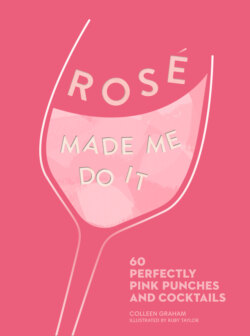Читать книгу ROSÉ MADE ME DO IT - Colleen Graham - Страница 7
ОглавлениеWHAT IS ROSÉ?
In nature, there are red grapes and white grapes, and within those, hundreds of varietals are used to make red and white wine, respectively. There are, however, no pink grapes, so how does one get the pink wines designated as rosés?
Rosé is not defined by the grape, but by the method. The catch is that since rosés are not varietal-dependent like other styles of wine, they offer a vast range of different flavour profiles. There are sweet rosés, a surprising number of dry rosés and plenty of sparkling rosés to choose from. Rosés are made in every corner of the globe, although there are areas in major wine-making countries that specialise in it. You will notice regional differences at times, just like with other wines, and you will encounter bottles that are a complete gamble. Will it be sweet or dry? Sometimes it’s very hard to tell, but that’s part of the fun!
If your experience with rosé has been limited to white zinfandel (yes, the sweet wine that captures the attention of many young drinkers is a rosé), then you’ll be delighted to know that there really is a rosé for every wine drinker.
HOW IS ROSÉ MADE?
There are a few different methods for making rosé. The most common method used today begins with the juice of red grapes remaining in contact with the grape skin for a few days before the skin is removed. This short period of maceration results in a blush-coloured wine.
A few rosés use a direct pressing method whereby the grapes are pressed with the skins, which are then removed straight away, leaving behind a light pink juice.
A third approach is the saignée process (pronounced sehn-yay, French for ‘to bleed’). In this case, a little of the red wine juice is ‘bled off’ early in the maceration process while the wine is still pink. The result is both a useable rosé and a red wine.
Used less often, a fourth technique involves blending a red and white wine together. Some wine-making regions frown upon the method, and many don’t regulate it, but a number of rosé Champagnes rely on it.
STYLES OF ROSÉ
Rosé is French for ‘pink’; Spanish and Portuguese wines are labelled ‘rosado’, and Italian wines ‘rosato’. However, rosé is definitely not limited to these countries. Understanding the complex maze that is rosé’s many flavour characteristics is complicated, so we’ll only touch on this briefly to make navigating wine labels a little easier.
Rosé comes in many shades of pink. On the lightest side, you’ll find the drier rosés of Provence. This French region primarily makes rosé, offering zesty, refreshing wines that have long been held up as the standard. Following these are the pinot noir rosés, which are slightly earthier, with a bright, acidic fruitiness. Spain’s favourite grape – the tempranillo – produces a slightly darker rosé with a brilliant spiced-berry flavour and a slightly darker hue. Surprisingly, when it comes to the rosé colour spectrum, California’s famed white zinfandel falls right in the middle. If you’re looking for a sweet wine, a bottle of white zin is what you want.
As you move through the remaining red wine grapes, the rosés produced by them tend to get darker. From merlot and sangiovese to cabernet sauvignon and shiraz (or syrah), the pink begins to resemble red wine. The darkest rosés come from Tavel, a small area in France’s Rhone Valley that produces nothing but rosé. These offer the best choice for red wine lovers, with the perfect display of tannins against spicy berry flavours and an unusually dry palate.
All of the other styles of rosé produced throughout the world fall somewhere within that spectrum. There are great options from Germany (roséwein or Weissherbst), France’s Loire Valley (rosé d’Anjou) and the Austrian state of Styria. The Spanish rosados (including sparkling cavas) are light and fresh, while Portugal tends to produce rosados that are sweet and inexpensive, with a hint of sparkle. Moscato wines are sweeter, and Italy’s prosecco rosatos are known for their vivacious bubbles. Beyond all that, there are many rosés that don’t fit into any easily defined idea of regional or varietal characteristics.
Before we finish, there are just a few more simple notes to bear in mind. The driest rosés often come from the driest red wine grapes, such as grenache, cinsault and shiraz. Any rosé can be a blend of grapes or use a single varietal, so don’t rely on that. A sparkling wine with a label saying ‘frizzante’ is gently sparkling, and ‘brut’ means ‘dry’. When in doubt, simply read the winemaker’s notes on the label. And, if you’re intrigued by a bottle (even just the catchy label), try it! If you don’t like it on its own, there’s bound to be a cocktail that will doctor it up.
DRINKING ROSÉ
Despite all the variations, rosé always has a generalised flavour profile of strawberries or watermelon. It contains fewer tannins than red wines and is very easy to drink. Rosés are typically best when young, too, so drink them up, don’t store them!
For the most part, you’ll want to chill still rosé before drinking it, and sparkling rosés are best when ice-cold. You are free to stick to your own preferences, but since we’re mixing up cold rosé cocktails here, keeping bottles cold will definitely help the drinks along.
You will also be delighted to hear that rosé is the most versatile wine for food pairings. Don’t stress over which wine is best with steak or seafood – rosé can cover the entire gamut of foods, cuisines and courses, from canapés to dessert. Likewise, the cocktails you make with rosé will be a splendid match for any meal.
